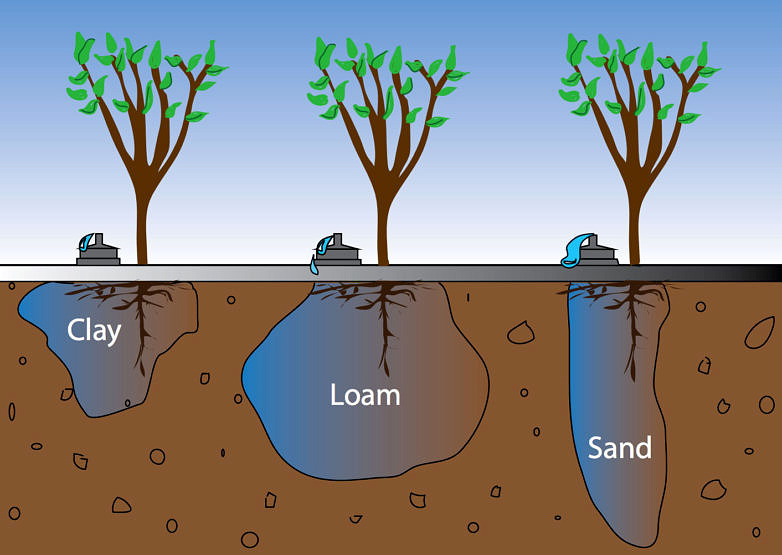
Learning to use water efficiently is especially important in water-strapped Central Texas. The type of irrigation systems and watering methods can greatly impact the amount of water consumed by your landscape. Use the information in the following tables to help design your own water-wise irrigation practices.
How Much Water is Used?
The amount of water delivered during a set period of time varies greatly on the type of sprinkler head or system being used. The following table provides general guidelines. Check the equipment rating for gallons per minute or gallons per hour to calculate the exact amount of output for your system. In general, drip irrigation is the most efficient system to use, but may not be suitable for turfgrass areas.
How Much Water Irrigation Equipment Delivers |
||||
| Method | Amount | Time | Efficiency | |
| Drip | 1/2 in | 60-70 minutes | 85% | |
| Rotor | 1/2 in | 45-60 minutes | 70% | |
| Spray | 1/2 in | 15-25 minutes | 50% | |
| Source: Dotty Woodson, retired Extension Program Specialist for Water Resources. | ||||
How Much Should You Water?
In Austin, temperature and rainfall can vary widely throughout the year, in addition to extended periods of drought. Use the following chart to help you plan when and how much you should be irrigating your lawn. Moisture requirements for trees and other plants will differ according to species, but you can use the same weather patterns to determine the water schedule.
How Much to Water – Turfgrass Weekly Water Requirements for Austin |
|||
| Daytime Temp (°F) | Full Sun | Part Shade | Full Shade |
| 101-105 | 1.75″ | 1.35″ | 1.15″ |
| 95 – 100 | 1.50″ | 1.25″ | 1.00″ |
| 90-94 | 1.25″ | 1.00″ | 0.75″ |
| 85-89 | 1.00″ | 0.75″ | 0.75″ |
| 80-84 | 0.75″ | 0.75″ | 0.75″ |
| 70-79 | 0.75″ | 0.75″ | 0.50″ |
| 70< | ———————Generally Not Needed—————————– | ||
| Source: Real Green Pest and Lawn | |||
How to Water Efficiently
The cycle and soak irrigation method reduces runoff and helps water to soak into the soil more deeply.
This method of applying water to the landscape is made up of multiple cycles for each station with 30 to 60 minute for the water to soak into the soil between cycles.
- The first cycle will break the surface tension of the soil and saturate the top layer of soil.
- The second cycle infiltrates the soil more efficiently and deeply after the first cycle.
- A third, and sometimes a fourth cycle, is beneficial if a slope is involved or if runoff occurs after the sprinklers run for just a few minutes.
The following table is an example of an irrigation system utilizing the cycle and soak method with eight stations running for two cycles. The example contains planting beds and turfgrass areas utilizing different spray types for each station.
How to Water – A Cycle and Soak Example |
|||
| Equipment | Area | Cycle 1 duration | Cycle 2 duration |
| Bed #1 Spray | Station 1 | 10 minutes | 10 minutes |
| Bed #2 Spray | Station 2 | 10 minutes | 10 minutes |
| Turf Area 1 Spray | Station 3 | 12 minutes | 12 minutes |
| Turf Area 2 Spray | Station 4 | 12 minutes | 12 minutes |
| Turf Area 3 Rotor | Station 5 | 25 minutes | 25 minutes |
| Turf Area 4 Rotor | Station 6 | 25 minutes | 25 minutes |
| Bed #3 Drip | Station 7 | 30 minutes | 30 minutes |
| Bed #3 Drip | Station 8 | 30 minutes | 30 minutes |
| Total Run Time: | 2 hrs 34 min | 2 hrs 34 min | |
| Example by Kirk Walden, Travis County Master Gardener and certified Irrigation Specialist | |||
You can calculate your own schedule by first conducting an irrigation audit using the Austin Water Residential Irrigation System Evaluation Instructions and Template. Once that’s done, use the Austin Water Evaluation and Runtime Calculator to finalize your cycle and soak schedule.
Soil Type Factors

Illustration courtesy of DripWorks: https://www.dripworks.com/blog/how-to-save-water-and-money-with-drip-irrigation
The soil type greatly impacts your cycle-and-soak duration times and the types of sprinkler heads or drip emitters to use. Clay, loam, and sandy soils absorb water at different rates.
Clay absorbs water slowly, causing it to spread more on the surface before soaking in to form an inverted cone shape below ground. This makes these soils more prone to run-off. Choose sprinkler heads or emitters that deliver water more slowly and increase your cycle-and-soak number of cycles. Loam soils, due to their larger particle size, absorb water more evenly and will form a wide pattern below ground. Sandy soils absorb water the fastest and will form an almost vertical pattern below ground. Choose sprinkler heads or emitters that can apply larger pattern widths of water. Sandy soils will require more frequent irrigation. While sandy soils aren’t prone to run-off, they can be more prone to flooding and soil displacement.
Additional Resources
Waterwise Landscaping main page

